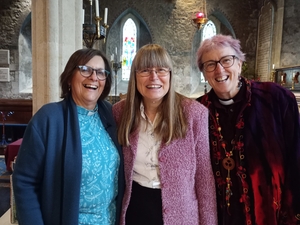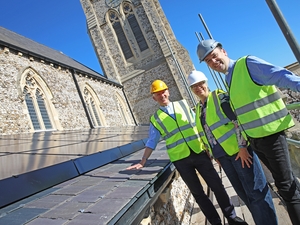
Diocesan Synod, March 2021
Diocesan Synod members met via Zoom, as the lockdown restrictions prevented members from meeting in person.
LIVE | PRAY | SERVE UPDATE
We were pleased that one of the major items on our Synod agenda was an update on the Live | Pray | Serve vision. And we’ve recorded our Diocesan Secretary Victoria James and the Archdeacon of the Isle of Wight Peter Leonard making their presentation, which you can watch here:
You can also download the Powerpoint presentation itself here (feel free to use the notes that accompany that presentation, which you can download from here). Or you can share the video of the presentation with your congregation by playing the Youtube version here.
You can see the various strands of the current process represented in the diagram below, which was shared at Diocesan Synod. The presentation of deanery plans to the bishop and senior staff was one strand, alongside several others. Peter Leonard explains this diagram in the video above.

Among other things, we’re pleased to see the common threads in the plans that each deanery presented to the bishop and senior staff. They include: shared leadership; focal leadership; clear local identity; lay and ordained people working in teams; and simplified growth-enabling governance.
There are also understandable fears, including the loss of local identity and focus; perceptions of inequality and takeovers; and the watering down of theology and specific churchmanships.
Victoria and Peter suggested that the average benefice is currently run by an all-rounder, who is expected to be multi-skilled and to multi-task. In future, we could have benefices composed of 4-8 churches, led by a team rector in a visionary role, with a bigger ministry team, shared governance, and a mixed ecology of congregations.
The four key elements to help us on the transformation journey were described as:
- Visionary leadership: we’ll expect the team rector to develop a vision, to be shaped and implemented by a team;
- Teams on a mission: we’ll create teams of different kinds, with different skills but shared values;
- Communities of kingdom-building disciples: we’ll nurture disciples who will help the Church to grow in depth and impact;
- Growth-enabling structures: we’ll change our structures to ensure each has a defined purpose and goal that drives their work, and each serves those on the frontline.
The next steps include Archdeacons discussing the plans with each deanery, and our Bishop’s Council consulting with parishes, before Diocesan Synod members examine the final diocesan-wide plan in June.
Members had questions about how different styles of worship and churchmanship might be preserved within the new team ministries; about the speed of change; about whether formal team ministries are desirable; and whether a single-parish structure is best. One member who is already in a new team ministry in Gosport offered to talk to members about its benefits.
Synod members agreed to endorse the direction of travel of the process. Members of Bishop’s Council will develop a Diocesan Plan, based on the deanery plans already submitted.
DIOCESAN STAFF TEAM
One aspect of our Live | Pray | Serve vision that we’ve already implemented is the restructure of our central staff team. We had to do this because the Covid pandemic affected our finances, and of course we were sad that it involved us losing valued team members. But we tried to use the restructure as an opportunity to find the best configuration of our resources to support the current vision.
Diocesan Secretary Victoria James presented a report on the restructure, which you can read here. She said there had been five redundancies, and that many of the remaining team members have seen their roles and/or line management structure re-shaped. The process has highlighted our shared diocesan values, and the grace and humility of team members who may have been receiving bad news was quite powerful.
Details of who now has which role, and how to contact them can be found here.
VACANCY-IN-SEE PROCESS
Another way in which members looked to the future was by thinking about the vacancy-in-see process, which will ultimately see the appointment of the next Bishop of Portsmouth. The chair of our vacancy-in-see committee, the Very Rev Anthony Cane, presented this paper, telling members that the group is currently consulting individuals and groups within the diocese before putting together the ‘Statement of Needs’ document. We’ll send this to the Crown Nominations Commission, which will identify suitable candidates.
PRESIDENTIAL ADDRESS
‘What is the Church for?’ was the title of Bishop Christopher’s presidential address, which looked back at the challenges of the pandemic as well as forward to future possibilities. He concludes that the Church is a community of people, made in the image of God, who seek closeness to God for themselves and others. That means Christianity can never be a private religion, but one that has solidarity with all God’s people and all that God has made. You can read the entire address here.
PARISH SHARE REVIEW
We’re also tackling a specific challenge that is a legacy of the pandemic: the calculation of parish share for 2022. The chair of our Diocesan Finance Committee, Philip Poulter, presented a paper which you can read here. Two of the elements we need to calculate future parish share aren’t available (average weekly attendance in each parish; and average weekly attendance across the diocese). Therefore we needed to move forward in two stages:
- an immediate solution to ensure a fair allocation of parish share for 2022;
- a longer-term review to the allocation of parish share across the diocese.
Synod members agreed that both of these things should happen.
SAFEGUARDING UPDATE
We’re committed to ensuring that our churches are safe places for all those who attend and those we serve. Canon Anthony Rustell, who leads our Lay and Ordained Ministry department, talked about safeguarding, which has become one of his responsibilities under the recent restructure. He spoke about the work that had continued during the pandemic, including virtual and in-person training, casework and support for survivors. He also spoke about the Past Cases Review 2 process, in which each C of E diocese is looking afresh at every safeguarding case and concern in their files, to see whether any more can be done in each case. His presentation can be downloaded from here.
ENVIRONMENT AND DAC
Our commitment to preserving our environment has been made clear, most recently by focussing on this issue in Lent 2020 and Lent 2021. General Synod have committed the whole Church of England to reach net zero in terms of carbon emissions by 2030, which is a challenging target. The chair of our Diocesan Advisory Committee for the Care of Churches (DAC), Giles Chapman, presented this paper examining how our diocese might contribute towards that target.
Members accepted the General Synod motion and are committed to take the action needed. Some members had questions about whether this was a realistic timeframe; others considered that having a challenging target was helpful. You can read more about our diocese’s commitment to environmental sustainability here.
Giles also asked synod members to consider a changed format to quinquennial inspections (ie. which happen every five years) of church buildings. Synod members agreed that this inspection should now include questions about environmental sustainability, in order to help us reach the net zero carbon target by 2030.
CONCLUDING REMARKS
This was the final Diocesan Synod meeting chaired by Bishop Christopher. The chair of the House of Laity, Debbie Sutton, paid tribute to the way Bishop Christopher makes others feel valued and offers hospitality. She highlighted his outstanding pastoral gifts, suggesting that it was no coincidence that ours was a friendly, relational diocese, as we followed his model. She said: “Thank you, Bishop Christopher, for your friendship, your kindness, your unfailing courtesy and your ability to make time for the small but important things.” You can read her full tribute to the bishop here.
Bishop Christopher responded by noting that our diocese has the only House of Bishops which consists of just a single person. He paid tribute to those who had led the Houses of Clergy and Laity in his time as bishop, and the team of diocesan officers who facilitate the synod’s work.
He also said: “I’m the ninth Bishop of Portsmouth, and the ninth to bequeath to his successor a smaller Church than before. If you’re OK with that, I’m not.”
He suggested that an attitude of ‘one more heave’ or trying harder with the current structures, wasn’t going to be good enough. What we needed was a new strategy that was ‘mission-led and ‘finance-real’.


